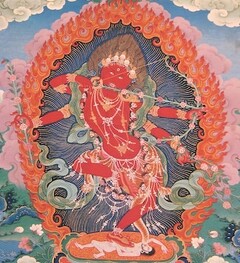Introduction to Kurukullā
Introduction to Kurukullā
by Stefan Mang
Kurukullā (Tib. rig byed ma) is a central female deity in Vajrayāna Buddhism, particularly associated with the Lotus family of the Buddha Amitābha. She embodies vaśīkaraṇa—the activity of magnetizing or enchanting—one of the four forms of enlightened activity in tantric Buddhism. Invoked for her power to attract, influence, and bring beings, circumstances, and even the practitioner’s own mind into harmony with the Dharma, Kurukullā is revered as a fully enlightened ḍākinī. She symbolizes the inseparability of bliss and emptiness (mahāsukha-śūnyatā), and her practices serve not merely as protective or worldly rites, but as profound methods for spiritual realization.
Iconographically, Kurukullā is portrayed as a radiant red ḍākinī, adorned with flowers and bone ornaments, dancing in a dynamic posture. In two-, four-, six-, or eight-armed forms, she holds a bow and arrow made of flowers, a noose, and a goad—implements that represent her power to bind, enchant, and magnetize beings onto the path. A crown bearing the image of Amitābha affirms her place within the Lotus family. While her red form—associated with magnetizing and the transformation of desire—is the most prevalent, peaceful white emanations connected with healing and longevity are also found.[1]
Kurukullā, regarded as a form of the goddess Tārā—who herself is an emanation of the bodhisattva of compassion Avalokiteśvara—embodies all-encompassing compassion, expressed through irresistible wisdom and the transformative power of attraction. Her presence in tantric cycles such as the Hevajra Tantra and the Sādhanamālā reflects her early prominence in Indian Buddhist esotericism. The Practice Manual of Kurukullā (Toh. 437, Kurukullākalpa), preserved in both Sanskrit and Tibetan, is the most comprehensive single text devoted to her, outlining a wide array of ritual methods including sādhanas, fire offerings, and medicinal or magical rites. These reveal a blend of apotropaic and liberative aims—protecting beings while drawing them closer to awakening.[2]
The historical origins of Kurukullā point to a synthesis of Buddhist and non-Buddhist tantric traditions. Scholars have suggested links to a mountain named Kurukullā in Gujarat and noted resonances with Hindu goddesses such as Lalitā of the Śrīvidyā tradition.[3] However, while her iconography and functions may overlap with such figures, Kurukullā is not a simple adoption. Rather, she emerges as a distinctly Buddhist embodiment of magnetizing wisdom—shaped by a shared tantric culture but uniquely integrated into Buddhist ritual, cosmology, and soteriology.
Kurukullā is thus revered as a complete meditational deity—a yidam—who channels the red, passionate force of enlightened activity. Her practice draws beings not through coercion or fear, but through the compelling radiance of wisdom and compassion. She stands as one of the clearest expressions of the tantric principle that desire itself, when skillfully understood and transformed, becomes a direct path to liberation.[4]
Further Reading
Bhattacharyya, Benoytosh, ed. The Sādhanamālā. 2nd ed. Baroda: Oriental Institute, 1968.
Buddha Śākyamuni. “The Practice Manual of Noble Tārā Kurukullā.” Translated by Dharmachakra Translation Committee. 84000: Translating the Words of the Buddha, 2024. https://84000.co/translation/toh437.
Mehta, R. N. “Kurukullā, Tārā and Vajreśī in Śrīpura.” In Tantric Buddhism: Centennial Tribute to Dr. Benoytosh Bhattacharyya, edited by N. N. Bhattacharyya. Reprint edition. New Delhi: Manohar, 2005.
Padmasambhava. Dakini Activity: The Dynamic Play of Awakening. Trans. Erik Pema Kunsang and Marcia Schmidt. Rangjung Yeshe Publications, 2018.
Pandey, Janardan Shastri, ed. Kurukullākalpaḥ. Rare Buddhist Texts Series, 24. Sarnath, Varanasi: Central Institute of Higher Tibetan Studies, 2001.
Shaw, Miranda. Buddhist Goddesses of India. Princeton: Princeton University Press, 2006.
Slouber, Michael. “Gāruḍa Medicine: A History of Snakebite and Religious Healing in South Asia.” PhD dissertation. University of California, Berkeley, 2012.
Snellgrove, David. The Hevajra Tantra: A Critical Study. London and New York: Oxford University Press, 1959.
Version: 1.0-20250711
